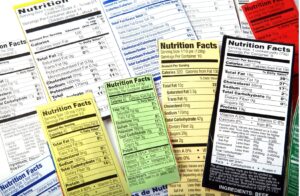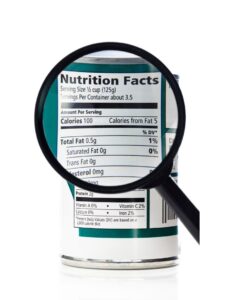Published 29 April 2022 ● Last Updated on 1 June 2022

Food, one of the basic necessities of humankind, has long surpassed the necessity status and gone on to take a fancier role in our lives. From eating to satiate hunger and derive strength from the nutrients in the food, food itself has become more of a fashion statement. Leading this pageant is food in fancy packaging straight out of the factory!
A factory is defined as a production plant where they manufacture items or operate machines which process each item into another. The key words here are ‘process each item into another’. Packaged food is not food like nature intended it to be and that is reason enough to read and understand that label on the packet of food.
Today, a food label is like the synopsis of the story you find on the cover of a book, it gives a gist of all that is in that tin can, plastic or paper bag or tetra pack and what that translates into for you. But do we as consumers read the label before we pick up that energy drink or do we settle for what the manufacturer wants us to read to make the purchase?
The “Watch List”

Food labelling is essential, and it is mandated by law for all packaged food to have food labels. Labels help consumers make informed decisions when purchasing food and helps them to store and use the food they’ve purchased safely. They provide nutrition facts and tell you what ingredients have been added into the packaged food. Labels can also mention the country of origin of the food, whether the food is organic, and certain health claims. In general, the must have items on the label are:
- Description or technical name of the food or drink (not the brand)
- Net weight or volume – amount of food or drink without the weight of the packaging
- Date mark
- Ingredient List, including additives starting from maximum to minimum quantity
- Nutrition information panel
- Allergy warning or Allergen declaration
- Name and address of manufacturer, distributor or importer
- Country of origin
- Storage Instructions e.g. keep refrigerated at 4°C
- Lot or batch number
- Label must be in English- As per FDA
- Labels should not bear inappropriate claims -As per FDA
Read carefully and make your own decisions!
Many marketing terms used on food labels are associated with improved health. These can often be misleading, so read read read!
- When a product claims to be Light, it is often either super-processed to reduce either calories or fat or simply watered down. Read carefully to see what they have added to make it taste nice, extra sugar perhaps.
- Unless marked whole grain, a Multigrain product is just an amalgamation of different types of refined grains – suggesting more health benefits than it has.
- Natural, does not necessarily mean that the product is natural. It may simply indicate that the manufacturer worked with a natural source such as fruits or grains.
- Don’t be taken in by the Organic labeling, because there could yet be hidden items like sugar.
- No Added Sugar is a big one; some products are naturally high in sugar, so the fact that they don’t have added sugar doesn’t mean they’re healthy. Often sugar substitutes which can cause health issues are added.
- Low Cal products should have one-third fewer calories than the brand’s original product but one brand’s low-calorie version may not have similar calories as another brand’s original.
- Low Fat would usually mean that the fat has been reduced at the cost of adding more sugar. Read the ingredients list carefully to understand.
- Carbohydrates are often made the villains for weight gain and so we go Low Carb. Processed foods that are labeled low carb often have several additives to enhance the taste.
- When you read, Made With Whole Grains, check the ingredients list — if whole grains aren’t in the first three ingredients, the amount is negligible.
- When some nutrients are added to a product it is often called Fortified or Enriched; just because something is fortified it doesn’t make it healthy.
- Gluten Free is not always healthy; many gluten free foods are highly processed and loaded with unhealthy fats and sugar.
- Some processed foods have names that indicate natural flavours, like mango yoghurt, the product may however not contain any fruit. The Fruit Flavor is likely from chemicals designed to mimic the original taste.
- Zero Trans Fat means less than 0.5 grams of trans fat per serving of the product. However, if the serving sizes are misleadingly small, the product may still contain trans fat.
Mirror mirror on the wall, sugar is the worst of them all
What makes processed food unhealthy is mostly the amount of sugar that’s hidden in it. When you read the labels for sugar, it could be quite misleading as sugar is known by various names on the label some of which you may not be able to recognise.

Watch out for these most common names of sugar in ingredient lists:
Sugars – beet sugar, brown sugar, buttered sugar, cane sugar, caster sugar, coconut sugar, date sugar, golden sugar, invert sugar, muscovado sugar, organic raw sugar, raspadura sugar, evaporated cane juice, and confectioner’s sugar.
Syrup – carob syrup, golden syrup, high-fructose corn syrup, honey, agave nectar, malt syrup, maple syrup, oat syrup, rice bran syrup, and rice syrup.
Added sugars – barley malt, molasses, cane juice crystals, lactose, corn sweetener, crystalline fructose, dextran, malt powder, ethyl maltol, fructose, fruit juice concentrate, galactose, glucose, disaccharides, maltodextrin, and maltose.
If you see any of these in the top spots on the ingredients lists — or several kinds throughout the list — then the product is high in added sugar. As a rule of thumb, the ingredient that weighs the most is listed first, and the ingredient that weighs the least is listed last on the food label.
The 5/20 rule
5/20 is a rule that can help you navigate through confusing nutrition labels.
- It indicates that a 20% or more daily value of any nutrient is a high amount, while 5% or less is low.
- If you’re looking for low sodium, for example, make sure the daily value is 5% or lower. If you want to boost your potassium, look for at least a 20% daily value.
The last word
Despite exercising extreme caution, one can yet be carried away thinking a processed pack is healthy. Always remember to avoid being misled by the labels, avoid processed food. After all, real food doesn’t need an ingredients list!
The gut is called the second brain because research proves that there is a lesser-known nervous system in our gut that constantly communicates with the brain and together “our two brains” play a key role in overall health and certain diseases in our bodies, we literally are what we eat. Eating healthy means choosing lots of different types of food throughout the day to get all the nutrients you need, such as vitamins, minerals, protein, carbohydrates, fiber and even fat.
So that box of cereal could be fortified with iron and have vitamins and minerals but what else does it have and is it all good for the gut? Remember to read the food label before you reach out for it.
Related Articles
Buying without packaging? These shops make zero waste possible in Singapore
Sustainable Singapore| A guide to buying foods grown and produced in SG




0 Comments